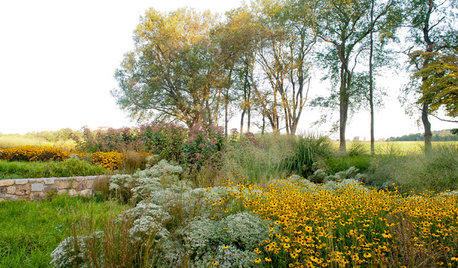corn and peanuts for wildlife
taragirl
15 years ago
Related Stories

GARDENING FOR BUTTERFLIESGarden for Wildlife to Reap Rich Rewards
When you plant with animals and insects in mind, you make gardening easier, the planet healthier and yourself more present
Full Story
GARDENING GUIDES6 Plants That Beat Butterfly Bush for the Wildlife Draw
It's invasive, a nonnative and a poor insect magnet. Check out these better alternatives to butterfly bush in the garden
Full Story
GARDENING GUIDES10 Deer-Resistant Native Flowers to Plant This Fall
Learn about natives that embrace some kinds of wildlife but resist grazing deer
Full Story
CENTRAL PLAINS NATIVE PLANTS10 Top Grasses for the Central Plains
Low-maintenance grasses provide seasonal interest and wildlife habitat, and aid good design
Full Story
GARDENING GUIDESGarden-Friendly Native Alternatives to Overplanted Exotics
There are lots of gorgeous, wildlife-friendly native plants ready to make an appearance in your garden
Full Story
GARDENING GUIDES10 Essential Wildflowers for the U.S. Central Plains
Focusing on prairie wildflowers supports the most wildlife in a low-maintenance Plains landscape
Full Story
FALL GARDENING7 Reasons Not to Clean Up Your Fall Garden
Before you pluck and rake, consider wildlife, the health of your plants and your own right to relax
Full Story
GARDENING GUIDESBackyard Birds: How to Care for American Goldfinches
The American goldfinch is a bright-in-the-summer visitor and one of the only vegetarian songbirds. Here's how to give them a healthy habitat
Full Story
EARTH DAY5 Ideas for a More Earth-Friendly Garden
Consider increasing the size of garden beds, filtering rainwater and using plants to reduce energy use
Full Story
GARDENING GUIDESThe Art of Green Mulch
You can design a natural garden that doesn’t rely on covering your soil with wood and bark mulch
Full StoryMore Discussions






midwesternerr
taragirlOriginal Author
Related Professionals
Arnold Landscape Architects & Landscape Designers · Clemson Landscape Architects & Landscape Designers · Kenmore Landscape Architects & Landscape Designers · Leawood Landscape Architects & Landscape Designers · Rossville Landscape Architects & Landscape Designers · Sand Springs Landscape Architects & Landscape Designers · Sahuarita Landscape Architects & Landscape Designers · Alexandria Landscape Contractors · Peabody Landscape Contractors · Bellefontaine Neighbors Landscape Contractors · Rockwall Landscape Contractors · Waipahu Landscape Contractors · Hockessin Driveway Installation & Maintenance · Pawtucket Driveway Installation & Maintenance · South Riding Swimming Pool Buildersontnative
dirtgirl